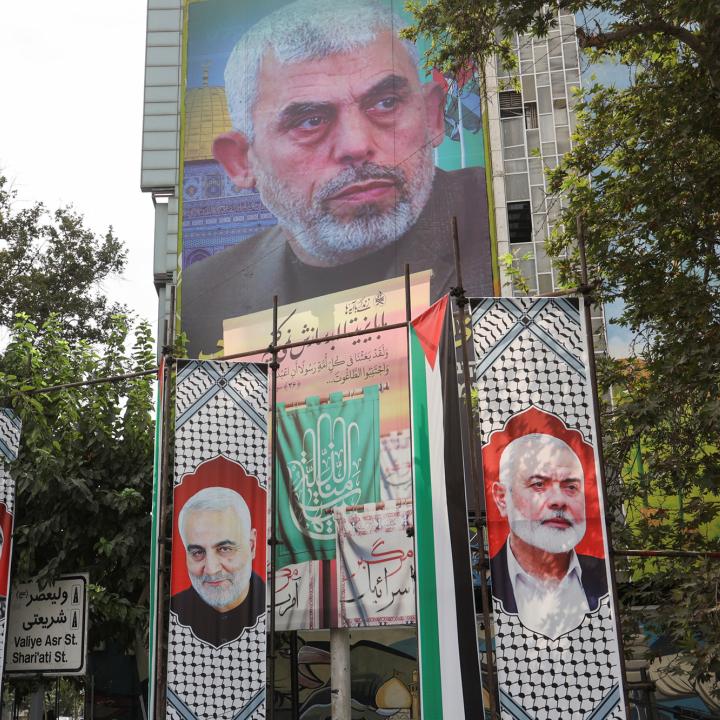

The demise of the Hamas leader and October 7 plotter could create significant diplomatic opportunities for Israel and the United States.
The killing of Hamas leader Yahya al-Sinwar—a unique figure who combined military and political credentials and masterminded the October 7, 2023, terrorist attack against Israel—marks a highly significant blow to Hamas and a dramatic military and psychological achievement for Israel. His death will have implications for the structure and dynamics of Hamas’s leadership, its strategic trajectory, and its future control of Gaza, as well as hostage release and ceasefire talks. While Hamas will likely appoint a replacement as soon as possible, no prospect is likely to be as effective as Sinwar, and not all will be committed tactically to his path.
On the political level, the remaining Hamas leadership in Gaza does not include a figure capable of succeeding Sinwar. The next leader will almost certainly come from the movement’s leadership in Doha, where the two main aspirants hold differing views on the ceasefire issue and Hamas’s regional alliances, particularly with Iran.
Khalil al-Hayya, the number-two in Hamas behind Sinwar, was a close ally of the late leader and headed the group’s delegation in ceasefire negotiations, as well as recent reconciliation talks with the rival Fatah movement. He will likely seek to continue Sinwar’s path both in the Gaza war front and in staying close to Iran. Khaled Mashal, the other likely candidate, served previously as Hamas’s leader for two terms. His relations with Iran are practically nonexistent, and he has long tried to move Hamas away from the Iranian axis and closer to the movement’s origins in the Muslim Brotherhood. He is likely to be more interested in reaching a ceasefire and in thus capitalizing diplomatically by positioning Hamas as the indispensable Palestinian interlocutor. Neither of these leaders, however, has the heft or relationships to effectively wield authority over the military wing in Gaza.
Whereas both Hayya and Mashal have a measure of political clout within Hamas, no current figure has the military stature of Sinwar, especially given Israel’s killing earlier this year of both Marwan Issa and Muhammad Deif. The two remaining contenders are Izz al-Din Haddad, Hamas’s military head in northern Gaza and a member of the movement’s military council, and Muhammad Sinwar, the late leader’s brother and right-hand man, who rose to prominence for his part in the 2006 kidnapping of Israeli soldier Gilad Shalit. A division of labor between the two is not out of the question.
In the short term, Sinwar’s killing will undoubtedly create additional chaos on the ground, with possibly dire implications for the hostages. The remaining Hamas leadership will try to show that it is undeterred by launching rockets into Israel and redoubling its efforts to destabilize the West Bank, although its ability to do either may be limited. Harm to the hostages could be carried out either as an act of revenge or to impose a cost on Israel.
The effects of Sinwar’s killing on Gaza public opinion also bear watching. The steep costs of the war have driven what appears to be growing anger at Hamas, as well as at Israel, and fear of the group is likewise persistent. The killing likely will embolden some Gazans to more openly express dissent.
In the longer term, Sinwar’s killing could emerge as a true game changer that opens up the possibility for political initiatives. Sinwar was seen as the main Hamas obstacle to a ceasefire deal, and his absence may reopen prospects for one. Israeli prime minister Binyamin Netanyahu has already offered hostage takers an option to surrender alive. President Biden also noted the potential for a breakthrough. But for this to succeed, these ideas need to be translated into operational policy very soon.
In particular, Israel needs to be willing to present a “day after” plan that creates the conditions for ending the war and rebuilding Gaza. Such a plan will need to be based on a hostage deal and Hamas’s disarmament, as well as the expulsion of its leadership and military operatives abroad. But it also needs to include a role—even if symbolic—for the Palestinian Authority (PA) and a pathway to ending the Israeli-Palestinian conflict. This will be required to enable third parties, particularly regional ones, to play a role in postwar Gaza. If coupled with efforts to rehabilitate the PA and create a credible pathway to ending the broader conflict, it could also shift the Palestinian balance of power away from Hamas.
More broadly, if new dynamics created by Sinwar’s killing can be leveraged toward a ceasefire, this could have implications for ending the war in Lebanon. Such a shift would deprive Iran of two of its most valuable regional assets and, in doing so, diminish its pernicious influence in the region. All these developments create new potential, but the U.S. administration will need to take the initiative and grasp the opportunity.
Ghaith al-Omari is the Gilbert Foundation Senior Fellow at The Washington Institute. Neomi Neumann is a visiting fellow at the Institute and former head of the research unit at the Israel Security Agency.



